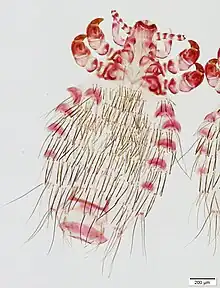Polyplacidae
Polyplacidae is a family of lice in the suborder Anoplura, the sucking lice. Lice in this family are known commonly as the spiny rat lice.[1] The family has a cosmopolitan distribution. As of 2010 there were 193 species.[2]
| Polyplacidae | |
|---|---|
 | |
| Eulinognathus denticulatus | |
| Scientific classification | |
| Domain: | Eukaryota |
| Kingdom: | Animalia |
| Phylum: | Arthropoda |
| Class: | Insecta |
| Order: | Psocodea |
| Suborder: | Troctomorpha |
| Infraorder: | Nanopsocetae |
| Parvorder: | Phthiraptera |
| Superfamily: | Anoplura |
| Family: | Polyplacidae Fahrenholz, 1912 |
| Genera | |
|
See text | |
These are small to medium-sized lice. They are usually sexually dimorphic. They have 5-segmented antennae and small, slender, clawed forelegs. Their middle and hindlegs may be almost equal in size, or the hindlegs may be larger.[3]
Lice in this family are parasites of many types of small mammals, including spiny rats, cavies, rabbits, hares, chinchillas, bushbabies, lemurs, squirrels, shrews, pouched rats, treeshrews, hyraxes, and Oriental dormice.[2]
Members of this family are quite variable based on its current description and molecular data suggest that the family is paraphyletic. It requires study and a revision to make the description of the family as a whole more accurate.[2]
Genera include:[4]
References
- Classification of Phthiraptera (Anoplura). An Introduction To Entomology. Discoveries in Natural History & Exploration. University of California, Riverside.
- Light, J. E., et al. (2010). Evolutionary history of mammalian sucking lice (Phthiraptera: Anoplura). BMC Evolutionary Biology, 10(1), 292.
- Durden, L. A. & Webb, J. P. (1999). Abrocomaphthirus hoplai, a new genus and species of sucking louse from Chile and its relevance to zoogeography. Archived 2016-03-04 at the Wayback Machine Medical and Veterinary Entomology, 13(4), 447-452.
- Polyplacidae. Integrated Taxonomic Information System (ITIS)
![]() Media related to Polyplacidae at Wikimedia Commons
Media related to Polyplacidae at Wikimedia Commons